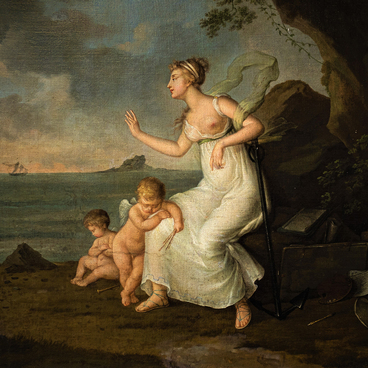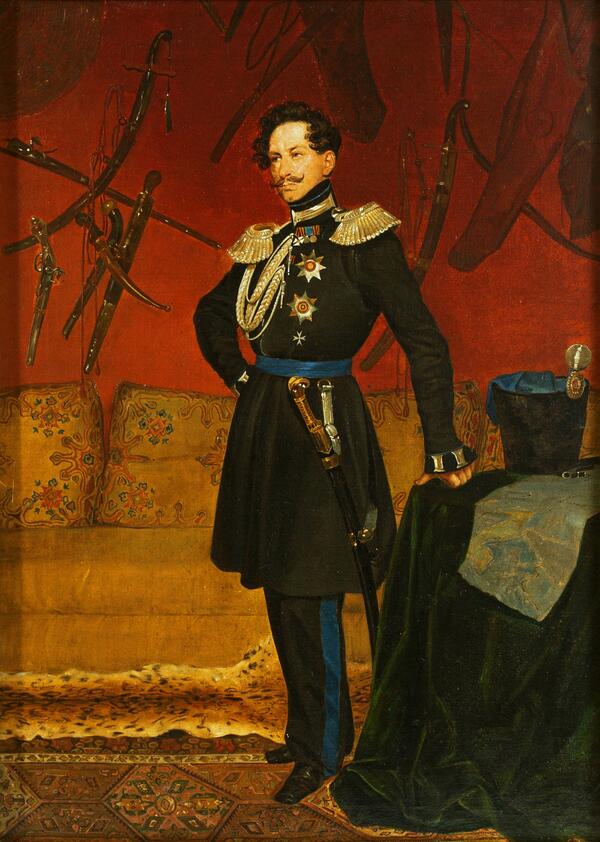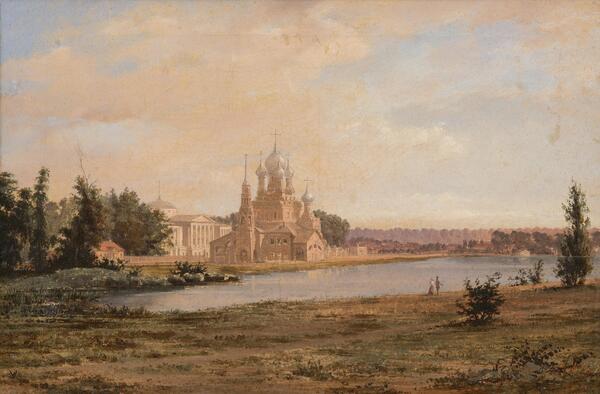Russian artist Vasily Raev painted ‘Landscape with Bathers’ in the early 19th century. The canvas possesses elements of genre painting, which mainly focuses on everyday scenes.
The main characters of this painting are young women resting on the shore. In the middle ground, the artist depicted a pond with dark water. Its center depicts two bathers splashing. Another young woman scatters towards them to jump into the water, while the other two are already dressing on the walkway. Farther away on the grass, next to a wooden hedge, another group of women is depicted chatting.
Vasily Raev was born in 1808 in the village of Volok, Pskov province. His parents were serfs and belonged to the Kushelev landowners. In 1822 or 1823 (the exact date is unknown), the owner sent Raev to Stupin’s Arzamas School of painting. The teachers sent Raev’s drawings from life to St. Petersburg, to the Imperial Academy of Arts, where the young artist was assessed as promising and being ‘good at painting landscapes.’
Vasily Raev could not attend courses at the Academy of Arts, since he was a serf, but he received a ticket to the Hermitage to be able to create copies of paintings by famous artists.
In 1837, Raev received an order from entrepreneur Pavel Demidov to create several paintings with views of the Nizhny Tagil mines and factories, the Urals and Altai Mountains. After the Academy received these drawings in 1838, the faculty decided ‘to bring (his achievements) to the attention of His Imperial Majesty for him to be blessed with His most gracious benevolence.’ In 1839, the artist was freed from the Kushelevs.
That same year, the Academy awarded Vasily Raev the first silver medal ‘for success in painting’, and a year later he received the title of an unclassed artist. From 1842 up to 1845, he studied in Italy at the expense of Count Vasily Perovsky.
In 1845, Emperor Nicholas I ordered the establishment of a mosaic institution in St. Petersburg and a trial workshop in Rome. From 1847 up to 1849, Raev studied mosaic art in Italy along with other pensioners from the Academy of Arts. Upon his return to Russia, he worked for two years in the mosaic institution and completed the head in the icon of Isaac of Dalmatia for St. Isaac’s Cathedral.
In September of 1851, Raev received the title of academician. In 1854, the artist traveled abroad once again. Upon his coming back, he became friends with manufacturer and publisher Kozma Soldatenkov and moved to Moscow to oversee his art gallery till the end of his life. He also became interested in religious painting. Raev died in Moscow in 1870.
The main characters of this painting are young women resting on the shore. In the middle ground, the artist depicted a pond with dark water. Its center depicts two bathers splashing. Another young woman scatters towards them to jump into the water, while the other two are already dressing on the walkway. Farther away on the grass, next to a wooden hedge, another group of women is depicted chatting.
Vasily Raev was born in 1808 in the village of Volok, Pskov province. His parents were serfs and belonged to the Kushelev landowners. In 1822 or 1823 (the exact date is unknown), the owner sent Raev to Stupin’s Arzamas School of painting. The teachers sent Raev’s drawings from life to St. Petersburg, to the Imperial Academy of Arts, where the young artist was assessed as promising and being ‘good at painting landscapes.’
Vasily Raev could not attend courses at the Academy of Arts, since he was a serf, but he received a ticket to the Hermitage to be able to create copies of paintings by famous artists.
In 1837, Raev received an order from entrepreneur Pavel Demidov to create several paintings with views of the Nizhny Tagil mines and factories, the Urals and Altai Mountains. After the Academy received these drawings in 1838, the faculty decided ‘to bring (his achievements) to the attention of His Imperial Majesty for him to be blessed with His most gracious benevolence.’ In 1839, the artist was freed from the Kushelevs.
That same year, the Academy awarded Vasily Raev the first silver medal ‘for success in painting’, and a year later he received the title of an unclassed artist. From 1842 up to 1845, he studied in Italy at the expense of Count Vasily Perovsky.
In 1845, Emperor Nicholas I ordered the establishment of a mosaic institution in St. Petersburg and a trial workshop in Rome. From 1847 up to 1849, Raev studied mosaic art in Italy along with other pensioners from the Academy of Arts. Upon his return to Russia, he worked for two years in the mosaic institution and completed the head in the icon of Isaac of Dalmatia for St. Isaac’s Cathedral.
In September of 1851, Raev received the title of academician. In 1854, the artist traveled abroad once again. Upon his coming back, he became friends with manufacturer and publisher Kozma Soldatenkov and moved to Moscow to oversee his art gallery till the end of his life. He also became interested in religious painting. Raev died in Moscow in 1870.







